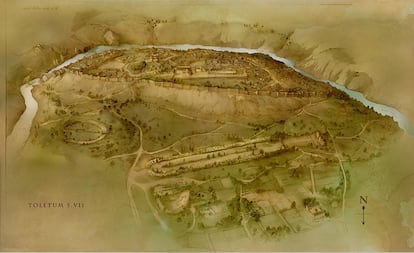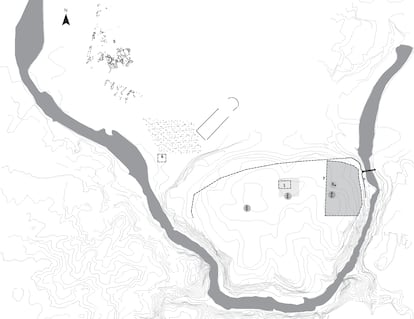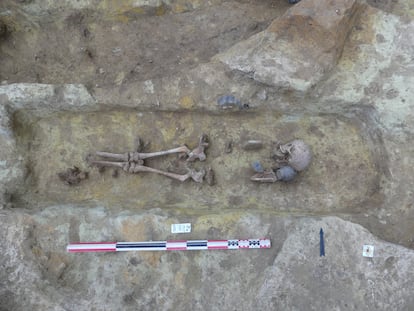What is hidden under the ground in Toledo, Spain?
A report argues that the site outside the walls did not house the Visigoth capital but rather recreational estates and Roman buildings


The political, cultural and urban planning battle that has been waged for years in Toledo’s Vega Baja—over a hundred hectares of undeveloped land at the foot of the hill of the walled imperial city—is far from over. Many Spanish and international organizations, academies and universities believe that Spain’s Vega Baja was the site of the Visigoth Urbs Regia, the area where the kingdom’s main buildings, from the royal palace to the coronation basilicas, were concentrated. The possible destruction of the ruins that do not fall under the protection of the area as a Site of Cultural Interest—there are plans to build thousands of houses on them—would be a scandal of monumental proportions. Icomos, an organization that advises UNESCO, describes the area as a “unique” place that can’t be duplicated, while the Academy of San Fernando speaks bluntly of its “plunder.” But there are reasonable doubts about what exactly is in the subsoil.
Two key facts fuel the mystery: in recent decades, there have hardly been any archaeological digs and all that we know about the site comes primarily from two types of sources: those written during that historical period and the current results from geo-radar or ground radar studies. Last week, it was reported that this non-invasive technique had detected “large buildings” and an edifice “similar to a Roman palace” on six unprotected plots. But in 2015 archaeologists Rafael Barroso Cabrera, Jesús Carrobles Santos, Jorge Morín and Isabel Sánchez Ramos wrote an article in the prestigious journal Antiquité Tardive (which is supported by Real Fundación Toledo [Toledo Royal Foundation], the Provincial Council, the Audema archaeological consultancy and Bordeaux-Montaigne University) in which they expressed their doubts that Vega Baja was the seat of the Visigoth capital. “For obvious reasons, nobody builds a capital outside the walls. The capital was on Toledo’s promontory,” they say.
The four experts believe that Vega Baja represented a peripheral space, not the suburb of the city, a populated area with buildings. Jorge Morín, the director of the Los Hitos Visigoth site and one of the leading Spanish experts on this period, says that the space “was occupied two thousand years ago by the Romans, as evidenced by the main structure [that is] still visible: one of the empire’s largest circuses.”
Morín reminds us that the area’s main physical characteristic is that it is prone to flooding because of its location on the banks of the Tagus River. Flooding occurs every 25, 50 and 100 years, “as different specialists—including Andrés Díaz Herrero, a professor in the Department of Geological Risks at the Geological and Mining Institute of Spain—have proven.”
When King Teudis built the Urbs regia [royal city], the Hispano-Visigoth community professed two faiths: Arianism and Catholicism. “The Catholics had the Saint Leocadia Martyrs Church in Vega Baja, while the Arian Visigoths had the cathedral church of Santa Maria, in the middle of Toledo.”

Experts say that topography has conditioned the city’s urban development for over 2,000 years. The imperial Puerta de la Bisagra [Bisagra Gate] already existed—in different forms—in Roman times, as well as in the Gothic period, as evidenced by the Mozarabic Chronicle of 754, which reported that Wamba restored it and ordered the placement of statues of saints and martyrs. Two millennia ago, where the Alcáza fortress is now located, there was a Roman praetorium [camp], which gave way to the Visigoth palace complex that, in turn, became the Andalusian citadel, then a medieval one and finally the Habsburgs’ palace.
During the Gothic period, the present-day Zocodover Plaza was an empty space separating the military area from the rest of the city. Meanwhile, the Roman forum was the site chosen for building the Visigoth cathedral, an area located between the Muslim mosque and the current cathedral. “That’s been the city’s layout since Roman times, and it has never changed. Treating Visigoth Toledo like Constantinople is absurd because its topography was totally different. In fact, the Byzantine capital’s hippodrome was next to the imperial palace but within its walls. On the other hand, in Toledo it was outside the walls, so it remained unused after the 2nd century and was not occupied by the Goths.”
The archaeological evidence shows that before settling in Toledo, the Visigoths’ first capital was Tolosa and then Barcelona “and [it was] always within the [city’s] walls.” “Vega Baja is an indefensible space and only a dimwit would think of settling there with a walled city behind [them]. For example, in preparation for the Battle of Navas de Tolosa, foreign contingents were forced to settle in Vega Baja to keep them under control, and in 1936, Colonel [José] Moscardó abandoned the Arms Factory [in Vega Baja] and settled in the Alcázar [in the city] ...”
Archaeologists believe that Vega Baja was a recreational space for urban elites, not a consolidated section of the Visigoth kingdom. Thus, we cannot see “the recently discovered buildings, which are just extensive properties that have their own enclosures or fences, as belonging to the Visigoth kings’ palatium. “Therefore, the monarchy’s palace and the new spaces of power had to be in the upper intra-wall part, following the Barcino [Barcelona, the first capital] scheme, next to the representative urban complexes associated with the ecclesiastical elites.”
“In Vega Baja, there were villas and a circus during the Roman occupation, then Goths’ residences, later a powerful emirate installation and subsequently medieval, modern and contemporary uses. “Many of those who are now presenting themselves as saviors are the ones who excavated and never published anything. When expectations are not met, eventually this situation is going to lead to the space being urbanized, which is significant in its own right, without the need to make up the idea that the Visigoth palatine complex is there,” Morín concludes.
Sign up for our weekly newsletter to get more English-language news coverage from EL PAÍS USA Edition
Tu suscripción se está usando en otro dispositivo
¿Quieres añadir otro usuario a tu suscripción?
Si continúas leyendo en este dispositivo, no se podrá leer en el otro.
FlechaTu suscripción se está usando en otro dispositivo y solo puedes acceder a EL PAÍS desde un dispositivo a la vez.
Si quieres compartir tu cuenta, cambia tu suscripción a la modalidad Premium, así podrás añadir otro usuario. Cada uno accederá con su propia cuenta de email, lo que os permitirá personalizar vuestra experiencia en EL PAÍS.
¿Tienes una suscripción de empresa? Accede aquí para contratar más cuentas.
En el caso de no saber quién está usando tu cuenta, te recomendamos cambiar tu contraseña aquí.
Si decides continuar compartiendo tu cuenta, este mensaje se mostrará en tu dispositivo y en el de la otra persona que está usando tu cuenta de forma indefinida, afectando a tu experiencia de lectura. Puedes consultar aquí los términos y condiciones de la suscripción digital.
More information
Archived In
Últimas noticias
The complicated life of Francesca Albanese: A rising figure in Italy but barred from every bank by Trump’s sanctions
Pinochet’s victims grapple with José Antonio Kast’s rise in Chile
Reinhard Genzel, Nobel laureate in physics: ‘One-minute videos will never give you the truth’
Half of Scotland is in the hands of 420 property owners
Most viewed
- Pablo Escobar’s hippos: A serious environmental problem, 40 years on
- Reinhard Genzel, Nobel laureate in physics: ‘One-minute videos will never give you the truth’
- Why we lost the habit of sleeping in two segments and how that changed our sense of time
- Charles Dubouloz, mountaineering star, retires at 36 with a farewell tour inspired by Walter Bonatti
- The Florida Keys tourist paradise is besieged by immigration agents: ‘We’ve never seen anything like this’










































